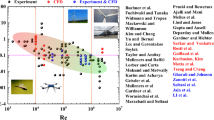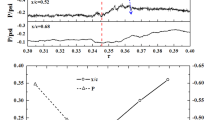Abstract
Dynamic stall on a helicopter rotor blade comprises a series of complex aerodynamic phenomena in response to the unsteady change of the blade’s angle of attack. It is accompanied by a lift overshoot and delayed massive flow separation with respect to static stall. The classical hallmark of the dynamic stall phenomenon is the dynamic stall vortex. The flow over an oscillating OA209 airfoil under dynamic stall conditions was investigated by means of unsteady surface pressure measurements and time-resolved particle image velocimetry. The characteristic features of the unsteady flow field were identified and analysed utilising different coherent structure identification methods. An Eulerian and a Lagrangian procedure were adopted to locate the axes of vortices and the edges of Lagrangian coherent structures, respectively; a proper orthogonal decomposition of the velocity field revealed the energetically dominant coherent flow patterns and their temporal evolution. Based on the complementary information obtained by these methods the dynamics and interaction of vortical structures were analysed within a single dynamic stall life cycle leading to a classification of the unsteady flow development into five successive stages: the attached flow stage; the stall development stage; stall onset; the stalled stage; and flow reattachment. The onset of dynamic stall was specified here based on a characteristic mode of the proper orthogonal decomposition of the velocity field. Variations in the flow field topology that accompany the stall onset were verified by the Lagrangian coherent structure analysis. The instantaneous effective unsteadiness was defined as a single representative parameter to describe the influence of the motion parameters. Dynamic stall onset was found to be promoted by increasing unsteadiness. The mechanism that results in the detachment of the dynamic stall vortex from the airfoil was identified as vortex-induced separation caused by strong viscous interactions. Finally, a revised criterion to discern between light and deep dynamic stall was formulated.












Similar content being viewed by others
Abbreviations
- a i :
-
ith Temporal eigenmode of the POD
- c :
-
Chord length
- C l :
-
Lift coefficient
- C m :
-
Pitching moment coefficient
- C p :
-
Pressure coefficient
- f osc :
-
Oscillation frequency
- k :
-
Reduced frequency
- Ma :
-
Mach number
- M :
-
Number of grid points
- n :
-
Probability density
- N :
-
Number of PIV velocity fields
- n :
-
Unit normal vector
- r eq :
-
Reduced pitch rate
- Re :
-
Reynolds number
- S :
-
Two-dimensional area
- t n :
-
Discrete time stamp
- t ss :
-
Time at which static stall angle is exceeded
- T :
-
Period of oscillation
- u = (u, v, w):
-
Local velocity
- \(U_{\infty}\) :
-
Free steam velocity
- x = (x, y, z):
-
Spatial coordinates
- α:
-
Angle of attack
- α0 :
-
Mean incidence
- α1 :
-
Oscillation amplitude
- αds :
-
Dynamic stall angle of attack
- αmax :
-
Maximum angle of attack
- αss :
-
Static stall angle of attack
- \(\dot{\alpha}_{\rm ss}\) :
-
Instantaneous effective unsteadiness
- \(\Upgamma\) :
-
Scalar function
- \({\Updelta t}_{\rm ds}\) :
-
Dynamic stall delay
- λ i :
-
ith Eigenvalue of the POD
- θ:
-
Velocity orientation angle
- ω:
-
Vorticity
- ψ i :
-
ith Spatial eigenmode of the POD
- \({\nearrow}\) :
-
During upstroke
- \({\searrow}\) :
-
During downstroke
- O :
-
Order of magnitude
References
Aubry N, Guyonnet R, Lima R (1991) Spatiotemporal analysis of complex signals: theory and applications. J Stat Phys 64:683–739
Beddoes T (1993) A third generation model for unsteady aerodynamics and dynamic stall. RP 908, Westland Helicopter Limited
Berkooz G, Holmes P, Lumley J (1993) The propor orthogonal decomposition in the analysis of turbulent flows. Ann Rev Fluid Mech 25:539–575
Carr L (1988) Progress in analysis and prediction of dynamic stall. J Aircraft 25(1):6–17
Carr L, McAlister K, McCroskey W (1977) Analysis of the development of dynamic stall based on oscillating airfoil experiments. TN D-8382, NASA
Chakraborty P, Balachandar S, Adrian R (2005) On the relationship between local vortex identification schemes. J Fluid Mech 535:189–214
Chong M, Perry A, Cantwell B (1990) A general classification of three-dimensional flow fields. Phys Fluids A Fluid Dyn 2:765–777
Cucitore R, Quadrio M, Baron A (1999) On the effectivenss and limitations of local criteria for the identification of a vortex. Eur J Mech B Fluids 18(2):261–282
Garth C, Gerhardt F, Tricoche X, Hagen H (2007) Efficient computation and visualization of coherent structures in fluid flow applications. IEEE Trans Visual Comput Graphics 13(6):1464–1471
Graftieaux L, Michard M, Grosjean N (2001) Combining PIV, POD and vortex identification algorithms for the study of unstready turbulent swirling flows. Meas Sci Technol 12:1422–1429
Haller G (2001) Distinguished material surfaces and coherent structures in three-dimensional fluid flows. Physica D 149:248–277
Haller G (2002) Lagrangian coherent structures from approximate velocity data. Phys Fluids 14(6):1851–1861
Haller G (2005) An objective definition of a vortex. J Fluid Mech 525:1–26
Ho C, Huerre P (1984) Perturbed free shear layer. Ann Rev Fluid Mech 16:365–424
Hunt J, Wray A, Moin P (1988) Eddies, stream, and convergence zones in turbulent flows. In: Proceedings of the summer program 1988, N89-24555, pp 193–208
Jeong J, Hussain F (1995) On the identification of a vortex. J Fluid Mech 285:69–94
Leishman J, Beddoes T (1989) A semi-empirical model for dynamic stall. J Am Helicopter Soc 34(3):3–17
Lekien F, Coulliette C (2001-2002) Mangen software package. http://www.lekien.com/francois/software/mangen/
Lugt H (1979) The dilemma of defining a vortex. In: Recent developments in theoretical and experimental fluid dynamics, Springer, Berlin, pp 309–321
Lumley J (1970) Stochastic tools in turbulence. Applied mathematics and mechanics—an international series of monographs 12. Academic Press
McAlister K, Carr L, McCroskey W (1978) Dynamic stall experiments on the NACA0012 airfoil. TP 1100, NASA
McCroskey W (1981) The phenomenon of dynamic stall. TM 81264, NASA
McCroskey W, Pucci S (1982) Viscous-inviscid interactions on oscillating airfoils in subsonic flow. AIAA J 20(2):167–174
Michard M, Graftieaux L, Lollini L, Grosjean N (1997) Identification of vortical structures by a non local criterion—application to PIV measurements and DNS-LES results of turbulent rotating flows. In: Proceedings of the 11th conference on turbulent shear flows, Grenoble, France
Obabko A, Cassel K (2002) Detachement of the dynamic stall vortex above a moving surface. AIAA J 40(9):1811–1822
Peacock T, Dabiri J (2010) Introduction to focus issue: Lagrangian coherent structures. Chaos 20:1–3
Peridier V, Smith F, Walker J (1991) Vortex-induced boundary layer separation. part 1. the unsteady limit problem \(Re\rightarrow\infty\). J Fluid Mech 232:99–131
Richard H, Bosbach J, Henning A, Raffel M, van der Wall B (2006) 2C and 3C PIV measurements on a rotor in hover condition. In: Proceedings of the 13th international symposium on applications of laser techniques to fluid mechanics, Lisbon, Portugal
Robinson S (1991) Coherent motions in the turbulent boundary layer. Ann Rev Fluid Mech 23:601–639
Shadden S, Lekien F, Marsden J (2005) Definition and properties of Lagrangian coherent structures from finite-time lyapunov exponents in two-dimensional aperiodic flows. Physica D 212:271–304
Sheng W, Galbraith RM, Coton F (2006) A new stall-onset criterion for low speed dynamic stall. J Sol Energy Eng 128:461–471
Sheng W, Galbraith R, Coton F (2008) Prediction of dynamic stall onset for oscillatory low–speed airfoils. J Fluids Eng 130:101(204–1–101,204–8)
Shih C, Lourenco L, Van Dommelen L, Krothapalli A (1992) Unsteady flow past an airfoil pitching at constant rate. AIAA J 30(5):1153–1161
Sirovich L (1987) Turbulence and the dynamics of coherent structures; part I, II and III. Q Appl Math 45(3):561–590
Wilby P (2001) J Am Helicopter Soc 46(3):210–220
Wu J, Ma H, Zhou M (2006) Vorticity and vortex dynamics. Springer, Berlin
Acknowledgments
The authors thank H. Mai, T. Büte, J. Nuhn, and A. Henning for their contribution to the wind tunnel measurements and K. Kindler for comments.
Author information
Authors and Affiliations
Corresponding author
Rights and permissions
About this article
Cite this article
Mulleners, K., Raffel, M. The onset of dynamic stall revisited. Exp Fluids 52, 779–793 (2012). https://doi.org/10.1007/s00348-011-1118-y
Received:
Revised:
Accepted:
Published:
Issue Date:
DOI: https://doi.org/10.1007/s00348-011-1118-y




